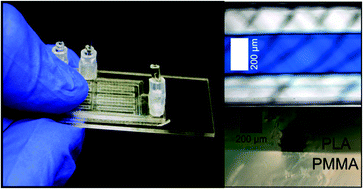A simple procedure to produce FDM-based 3D-printed microfluidic devices with an integrated PMMA optical window†
Abstract
Fused deposition modeling (FDM) is the lowest cost 3D-printing technology and has found application in microfluidics in the past few years. However, it lacks resolution and the ability to print transparent windows for optical detection. For this reason, we present a simple protocol to prepare 3D-printed microfluidic channels around 170 μm width and transparent windows using a 0.2 mm nozzle, poly(methyl methacrylate) (PMMA) as the transparent substrate and poly(lactic acid) (PLA) as the polymer filament. Due to the similar molecular structure of PLA and PMMA, outstanding bonding was achieved. After optimization of the printing settings, we found that a gap of 200 μm between the PMMA slide and the nozzle results in channels that present no leakage even with high flow rates of up to 2 mL min−1. As a proof of concept, we present bioanalytical applications for devices produced with this protocol, such as determination of nitrite, total proteins and nitric oxide, as well as microorganism visualization. We believe that this protocol can simplify the production of low-cost microfluidic devices containing transparent detection windows since it does not require tapes or glues, nor stopping the printing process to insert other materials, such as glass.



 Please wait while we load your content...
Please wait while we load your content...